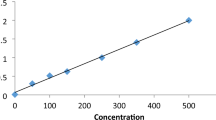Summary
The autoxidation of the antipsoriatic agent dithranol, monitored by an ESR-spectrometer, proceeds through several free radical intermediates. The initial radical, attacking a bulky spin trapping agent in a sterically comparatively hindered constellation, may be the active therapeutic form of dithranol.
Similar content being viewed by others
Literatur
Galewsky, Derm. Wschr.62, 113 (1916).
P.G. Unna, Derm. Wschr.62, 116 (1916).
W. Raab, Hautarzt26, 452 (1975).
H. Meffert and P. Reich, Derm. Mschr.155, 157 (1969).
S. Terabe and R. Konaka, J. Am. Chem. Soc.93, 4306 (1971).
T. Yatsu, S. Moriuchi and H. Fujii, Polymer J.9, 293 (1977).
G. Swanbeck and N. Thyresson, Acta derm-vener.45, 344 (1965).
Author information
Authors and Affiliations
Rights and permissions
About this article
Cite this article
Martinmaa, J., Vanhala, L. & Mustakallio, K.K. Free radical intermediates produced by autoxidation of 1,8-dihydroxy-9-anthrone (dithranol) in pyridine. Experientia 34, 872–873 (1978). https://doi.org/10.1007/BF01939674
Issue Date:
DOI: https://doi.org/10.1007/BF01939674




